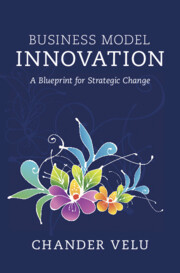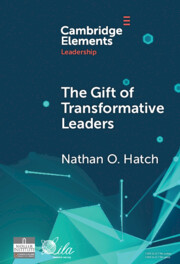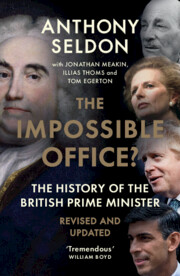380 results
Five Factors for Effective Policy to Improve Attitudes towards People with Disability
-
- Journal:
- Social Policy and Society , First View
- Published online by Cambridge University Press:
- 13 September 2024, pp. 1-14
-
- Article
-
- You have access
- Open access
- HTML
- Export citation
13 - The Conservative Party
-
-
- Book:
- The Conservative Effect, 2010–2024
- Published online:
- 24 July 2024
- Print publication:
- 27 June 2024, pp 412-445
-
- Chapter
- Export citation
Chapter 4 - Patterns of Industry
-
-
- Book:
- Nineteenth-Century Literature in Transition: The 1830s
- Published online:
- 30 May 2024
- Print publication:
- 06 June 2024, pp 84-104
-
- Chapter
- Export citation
Canadian Leader in Neurology: Thomas E. Feasby
-
- Journal:
- Canadian Journal of Neurological Sciences , First View
- Published online by Cambridge University Press:
- 24 May 2024, pp. 1-3
-
- Article
-
- You have access
- HTML
- Export citation
Conclusion
-
- Book:
- The Legal Brain
- Published online:
- 08 May 2024
- Print publication:
- 09 May 2024, pp 237-244
-
- Chapter
- Export citation
13 - The Neuro-intelligent Legal Organization
-
- Book:
- The Legal Brain
- Published online:
- 08 May 2024
- Print publication:
- 09 May 2024, pp 202-236
-
- Chapter
- Export citation

The Legal Brain
- A Lawyer's Guide to Well-Being and Better Job Performance
-
- Published online:
- 08 May 2024
- Print publication:
- 09 May 2024

Business Model Innovation
- A Blueprint for Strategic Change
-
- Published online:
- 02 May 2024
- Print publication:
- 09 May 2024
5 - The Portrayal of the Great Lady in the Maẓhar al-ʿajāʾib
-
- Book:
- Female Religiosity in Central Asia
- Published online:
- 25 April 2024
- Print publication:
- 02 May 2024, pp 92-115
-
- Chapter
- Export citation

The Gift of Transformative Leaders
-
- Published online:
- 17 April 2024
- Print publication:
- 16 May 2024
-
- Element
- Export citation
How Transformational Leadership Affects the Off-work Recovery of Daily Personal Energy Resources via Work Engagement: Resource and Demand-based Pathways
-
- Journal:
- The Spanish Journal of Psychology / Volume 27 / 2024
- Published online by Cambridge University Press:
- 05 April 2024, e11
-
- Article
-
- You have access
- Open access
- HTML
- Export citation
Improvisation pedagogy: what can be learned from off-task sounds and the art of the musical heckle?
-
- Journal:
- British Journal of Music Education , First View
- Published online by Cambridge University Press:
- 03 April 2024, pp. 1-11
-
- Article
-
- You have access
- Open access
- HTML
- Export citation
8 - Political Organization
-
-
- Book:
- Human Behavioral Ecology
- Published online:
- 07 March 2024
- Print publication:
- 14 March 2024, pp 180-202
-
- Chapter
- Export citation

The Impossible Office?
- The History of the British Prime Minister - Revised and Updated
-
- Published online:
- 14 March 2024
- Print publication:
- 14 March 2024
Chapter 8 - Cultural Carriers and the Failure of Revolutionaries to Reshape Behavior
- from Part III - What Happens after Revolutionary Regime Change?
-
- Book:
- The Psychology of Revolution
- Published online:
- 07 March 2024
- Print publication:
- 14 March 2024, pp 118-132
-
- Chapter
- Export citation
Chapter 3 - The Liminal Premiership
-
- Book:
- The Impossible Office?
- Published online:
- 14 March 2024
- Print publication:
- 14 March 2024, pp 69-111
-
- Chapter
- Export citation
7 - Status
-
-
- Book:
- Human Behavioral Ecology
- Published online:
- 07 March 2024
- Print publication:
- 14 March 2024, pp 153-179
-
- Chapter
- Export citation
19 - Using contemplative practices to enhance teaching, leadership and wellbeing
- from Part 3 - Social and emotional wellbeing
-
-
- Book:
- Health and Wellbeing in Childhood
- Published online:
- 08 March 2024
- Print publication:
- 04 March 2024, pp 305-320
-
- Chapter
- Export citation
Julie Christmas – President of BIALL
-
- Journal:
- Legal Information Management / Volume 24 / Issue 1 / March 2024
- Published online by Cambridge University Press:
- 10 May 2024, pp. 10-14
- Print publication:
- March 2024
-
- Article
-
- You have access
- HTML
- Export citation
5 - The Whole Is Greater than the Sum
-
-
- Book:
- Reimagining Philanthropy in the Global South
- Published online:
- 09 February 2024
- Print publication:
- 15 February 2024, pp 102-121
-
- Chapter
-
- You have access
- Open access
- HTML
- Export citation

